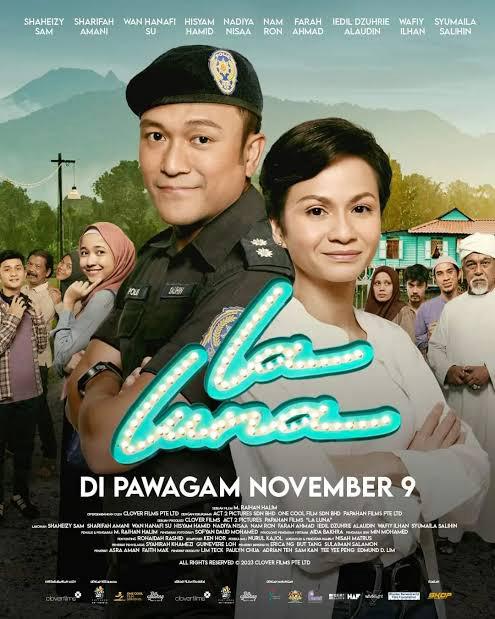La Luna
A Cinematic Revolution Embracing Taboos and Reshaping Muslim Orthodoxy
By Hajra Sumaira Imran

French existentialist philosopher, Albert Camus, said “Art should give us a final perspective on the content of rebellion”. Art has played a crucial role in revolting against the dictators of time and sustaining the warmth in life. In old times, an artist expressed his emotions through paintings, sculptures, and writings as they were the means to entertain people as well as satisfy an artist’s inner turmoil. This turmoil, a contrarian spirit against the conformity of society, always had and always will continue to produce artists. In the modern-day, cinema is the most effective means to tell stories and serve as a resistance to the status quo.
In this cinematic revolution, La Luna is a breath of fresh air as it tends to chisel right where it needs a break. It is a Singaporean and Malaysian film written and directed by M. Raihan Halim who has done a stellar job of addressing Muslim orthodoxy. The film is a breath of fresh air to answer the extreme views held against Muslim women and steer back from the fundamentalist perspective of being a Muslim. The plot of the movie is about a woman who opens up a lingerie store in a village headed by a staunch mullah. The film portrays the change brought by this store and the shifting attitude of the inhabitants of the village.
The film is a romantic comedy and it beautifully presses on the most taboo desire, intimacy. The most pleasant feature of this film was that there was no obscenity and yet it triumphs and delivers the message. The message is that there is no shame in admitting one’s carnal desires and channeling them holistically. The writer has tackled intimacy between a husband and wife by introducing just a piece of lingerie.
The role of Hanie Abdullah played by Sharifah Amani is strong and most importantly clear in her stance. In her, the writer has shown a fierce woman who does not shy away from voicing her opinion. The rousing sexuality of a teenage girl and boy is also covered in the characters of Azura and Yazid. The fightback of Yam against her abusive husband and the naughty yet necessary bond between Ayub and Enah.
In a Muslim society, the general perception is that women are oppressed and subjected to all kinds of violence. Their desires are repressed and they have no minds or voice of their own. It is true that all of this happens and that too in the guise of religion that women are made secondary creatures to obey men, especially their husbands. In the film, the writer has taken a multi-textural approach to address this misconception and also to strike down this volition against women.
Tok Hassan is a revered man who preaches religion but he is abusing his authority as a religious cleric. He is dictating everyone’s morals and stifling any kind of entertainment or joy. The winds change when Hanie opens up a lingerie store in the village and women buy her products or rather buy clothes for their own needs. The outcome of this intimate consumerism is simple, a satisfied couple and a more confident woman, both of which often become threats to many. It is funny but there is a deeper layer to this specific point. Why is a woman’s sexuality so repellent and must be hushed while men can proudly quote themselves to be masculine and show it off?

A woman’s undergarments must be hidden while with men it’s not much of a problem or a matter of shame. So it is a deep satire on the conservatives who can’t bear a couple enjoying their private time and appear to be simply happy. The second important character is Azura who is the daughter of Salihin, a policeman and the protagonist of the movie. In Azura, we see a girl becoming a woman recognizing her emotions and comically addressing them to tease her father. She wants to befriend a boy but Salihin plays a typical and yet not so typical role of a father. His concerns are genuine and not restrictive or bashing as any “normal” father would behave in a constricting society. The hypocrisy in most Muslim societies is that they will not allow their daughters to even look at any other man and then one day marry her off to any random man.
The third important character is Yam and through her, the writer addresses another important issue, domestic violence. Yam’s husband vents his frustration of being unemployed by beating her and the village cleric does nothing to rebuke him. The sheer hypocrisy is highlighted such that a battered wife is accepted but a wife buying lingerie to have a good time with her husband is threatening and depreciating the morality of the whole village.
Overall, it explores the beautiful bond between women and their teasing talk regarding amorous relationships. The men in the film are also portrayed not as cowards but as supportive of their women. When it comes to the end, they are all united in displacing the orthodox mullah who has stifled the joy of the village. But mostly, the women were shown as brave and wise enough to stand up for themselves stressing that women are complete individuals and there is nothing in the way to stop them except vile men.
The movie is a beautiful watch which I am sure you all will enjoy with your partners and friends. It will remove many misconceptions about Muslim communities and Islamic teachings in general. You will definitely think that things are not as threatening or obscene as they are made to think. How emotions and desires need to be experienced and not locked away labeling them as taboos.
You can also read a review of One Day: A Captivating Drama Series That Delves Deep Into Human Emotions.

